





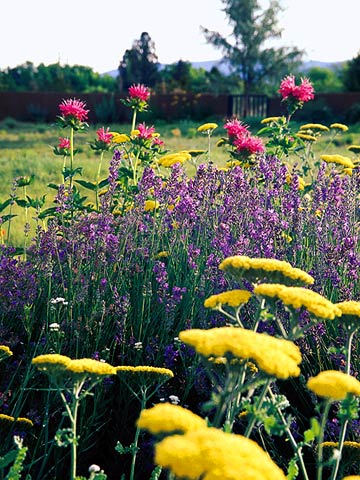 Pink bee balm, purple lavender,
and yellow yarrow create a summer-
long trio of bloom.
Pink bee balm, purple lavender,
and yellow yarrow create a summer-
long trio of bloom.
When a three-part color harmony relies solely on flowers, its timing must be in sync. Group three plants that should bloom about the same time in the season to make an effective trio. A late-spring design could include Oriental poppy, iris, and delphinium. Plan late-blooming replacements and extend the trio into midsummer. Let blue larkspur take over for the iris and add annual poppies to fill in after the Oriental poppy foliage fades.
What's the easiest way to start thinking in threes? Take a favorite flowering shrub, such as a rose or a long-blooming perennial, then showcase it with two foliage partners. Select foliage for its shape but also for factors such as fall color and tones that pick up color in the flowers' petals, stamens, or markings. Many flowers have golden stamens, so gold foliage often makes a good partner for them.
One-color gardens.
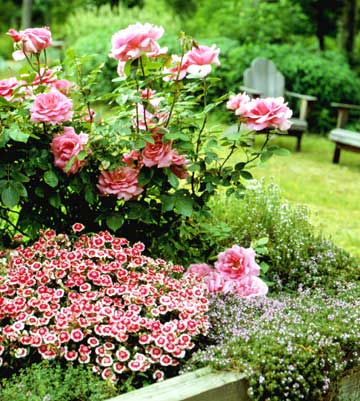 'Earth Song' grandiflora rose teams
with fragrant dianthus and thyme
at its feet. The foliage on the
early-summer blooming perennials
stays attractive all summer.
'Earth Song' grandiflora rose teams
with fragrant dianthus and thyme
at its feet. The foliage on the
early-summer blooming perennials
stays attractive all summer.
Triple the potential fragrance of roses by partnering them with small- and medium-height herbs. Versatile herbs possess aromatic appeal and they repel pests and soilborne diseases. Herbs also function as border edgers, perennial partners, and background choruses. Many of them have culinary uses, too.
Sprays of bright-blue borage flowers and their prickly silver-green leaves add a glow to blooming companions. Borage makes a winning partner with peach and yellow roses. It grows easily and rapidly from seed.
Place a fine-texture haze of color behind brilliant flowers with angelica, bronze fennel, tarragon, or a taller Artemisia, such as 'Silver King'. Add chartreuse highlights, especially among red or orange flowers, with dill or an arbor of golden hops. Artemisia, lavender, rosemary, and clary sage shine silver spotlights on white-and-pink or white-and-lavender combos.
For edging color and texture, rely on parsley, chives, sage (especially the purple and tricolor varieties), and globe basil. Creeping varieties of thyme and mint pave edges and walkways with shades of gold, purple, and green.
Two-color gardens.
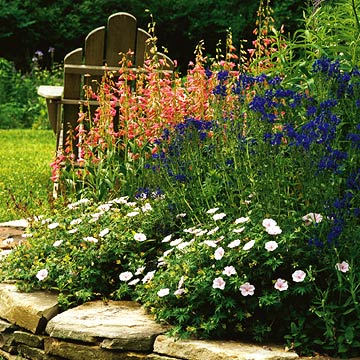 Tall penstemon, Delphinium
grandiflorum 'Blue Butterfly',
and pastel pink cranesbill
are an easy, reliable team.
Tall penstemon, Delphinium
grandiflorum 'Blue Butterfly',
and pastel pink cranesbill
are an easy, reliable team.
Spring wears a mostly subdued color wardrobe, except for the bright yellow exultations of daffodils and forsythia. The season is typically depicted in soft pink, lavender, and blue. These three pastel colors work well together and separately when mixed with yellow-green, silver, and the white of blossoming fruit trees.
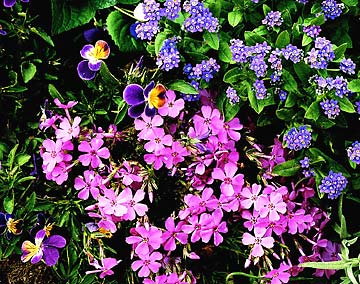 Pink creeping phlox, violet
violas, and blue forget-me-nots
create an unforgettable spring
trio of color.
Pink creeping phlox, violet
violas, and blue forget-me-nots
create an unforgettable spring
trio of color.
In spring, flowering bulbs appear first, often wearing complementary shades of purple or lavender and yellow. The earliest perennials soon follow and become colorful cover-ups for fading bulb foliage. Plant coral bells, periwinkle, dianthus, columbine, cushion spurge, and lady's mantle over and around spring bulbs.
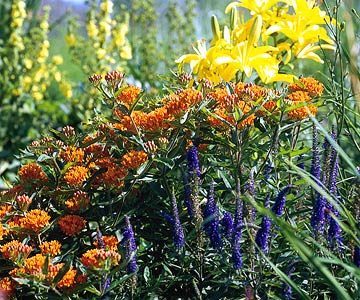 Red (hot) annual salvia and yellow
Gaillardia sizzle beside cooling
white Shasta daisies.
Red (hot) annual salvia and yellow
Gaillardia sizzle beside cooling
white Shasta daisies.
Summer favors a red-hot color scheme that stands up and shouts despite punishing heat. Beds and borders catch fire with golden yellows, searing reds, and volcanic oranges. When composing midsummer trios, always include at least one cooldown color to keep the fire under control. A splash of silver or dabs of white take the temperature down a notch. Calming pinks and blues also moderate hot colors.
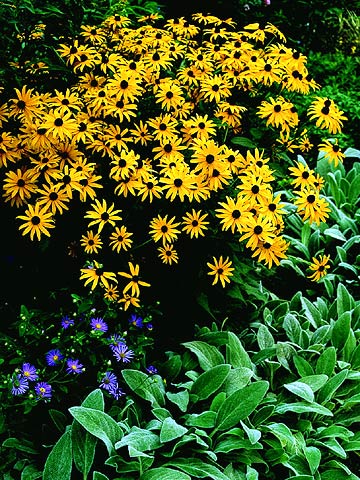 The gold blooms of black-eyed Susan
play out against the cooler
lavender aster and silvery fuzz
of lamb's ears.
The gold blooms of black-eyed Susan
play out against the cooler
lavender aster and silvery fuzz
of lamb's ears.
Winning three-way garden partnerships combine red, white, and yellow or orange. Orange, yellow, and blue-theme borders prove that one cool tone plus two fiery allies can hit it off. Midsummer blues come from bachelor's button, Campanula, delphinium, Ageratum, and ladybells. Purple, gold, and silver reflect the sun's glory in a cooler, sophisticated scheme. Imagine the refreshing and reflective nature of a shady summer oasis painted green, white, and lavender or pink.
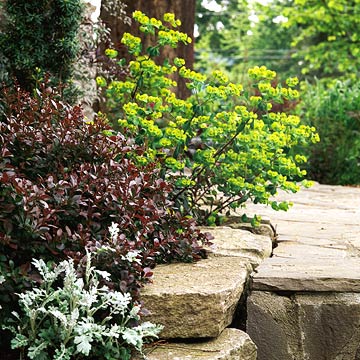 Silvery dusty miller (an
annual), purple barberry, and
Euphorbia wulfenii prove that
leaves can add as much color as
flowers.
Silvery dusty miller (an
annual), purple barberry, and
Euphorbia wulfenii prove that
leaves can add as much color as
flowers.
When leaves play together in three-part harmony, the garden gains textural dimensions as well as colorful special effects. The soft ripple of grasses and the whorled pinwheels of Euphorbia push the gardener's brushstrokes a step further into the complexities of shape and form.
Foliage eases the way to experimenting with color. Minus flower distractions, a collage of leaves clearly shows when color combinations work. Gather leaves from the plants you'd like to include in a garden vignette and arrange them next to one another on a sheet of paper. This will give you a compass bearing to follow with your garden's design. Add flowering plants last as seasonal accents among layers of ever-fascinating foliage.
Create a garden with colorful foliage.
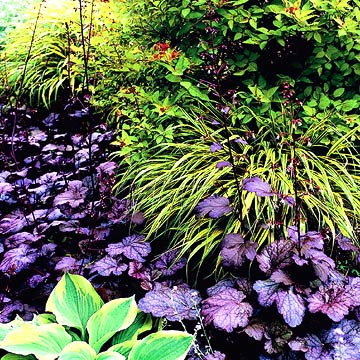 This shady glen glows with
purple Heuchera, green and gold
hosta, and golden Hakonechloa
grass.
This shady glen glows with
purple Heuchera, green and gold
hosta, and golden Hakonechloa
grass.
Most foliage hues mingle well. Striking burgundy or purple leaves and showy variegated foliage substitute for flowers in a leafy garden. Gold goes well with purple, and silver adds a muted sparkle to the trio. Silver, gold, and yellow-green variegated foliage compose a gorgeous blend. A landscape dominated by purple and silver foliage suggests an aura of somber mystery lightened somewhat by a chartreuse or gold highlight.
Copyright © www.100flowers.win Botanic Garden All Rights Reserved